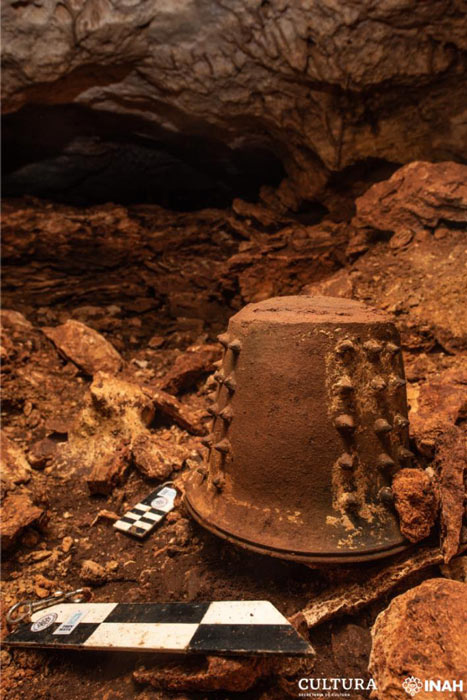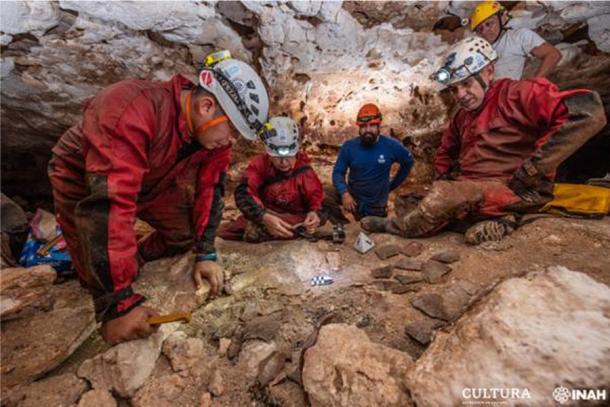An ancient wooden Maya canoe, believed to have been used more than 1,000 years ago, has turned up in San Andres, in the Yucatan area of southern Mexico. Almost 5 feet (1.6 meters) in length, the vessel was found in a remarkable state of preservation. It was submerged in a freshwater pool (called cenote) near the ruined city of Chichen Itza, which was once a center of Maya power and prestige.
The Tren Maya and INAH’s Research Opportunity
The discovery was made as part of President Obrador’s ambitious but highly controversial ‘Tren Maya’ project, under which hundreds of burials and ceramic vessels have been uncovered, as reported by Ancient Origins just last week. The Tren Maya, or Maya Train project , was launched as an inter-city rapid rail project that will run through the heart of the Yucatan Peninsula.
It has run into a lot of controversy, not just for its environmental red flags, but also because this peninsula is plentiful with indigenous Maya culture and sites. The Tren Maya is a multi-billion-dollar six-section construction project, and the Maya canoe discovery was made in Section IV, which goes from Izamal to Cancun, Quintana Roo.

The Maya canoe was discovered in a Yucatán cenote. (Oficina Península de Yucatán de la SAS-INAH )
This attack on the environment and culture has been met by some form of approval by researchers from the INAH (Instituto Nacional de Antropologia e Historia), Mexico, who are using this opportunity to preserve the elements of history coming their way. “The construction of the Mayan Train constitutes an important research opportunity, through archaeological recovery, with a view to expanding the knowledge about the archaeological sites of the regions that the train will travel through,” they said in a statement last week.
Was the Maya Canoe Made for Ritual Use?
The Maya canoe was possibly used for transportation purposes, either acting as a vessel to transport water, or to deposit ritual offerings, says INAH in another statement , as reported by The Yucatan Times . They add that, “The relevance lies in the fact that it is the first canoe of this type that is complete and so well preserved in the Mayan area, and there are also fragments of these boats and oars in Quintana Roo, Guatemala and Belize.”

Artifacts suggest that this was a ritual site. (Oficina Península de Yucatán de la SAS-INAH )
They also add that experts from the Parisian Sorbonne University will help in dating and analyzing the wood. Additionally, a 3-D model of the canoe will be commissioned to allow further study and replicas to be made.
The head of the Yucatan Peninsula Office of the SAS, Helena Barba Meinecke, says, “The interesting thing was that while we were taking a break for decompression in the cenote, necessary when diving more than 20 meters deep and exceeding a certain time defined in the dive tables, I noticed that five meters below the current water level there was a dark imprint on the stone wall, which was between 60 to 90 centimeters, and indicated the old water level.”
The canoe in question is from the Terminal Classic period in Maya history, between 830 and 950 AD. This roughly coincides with the end of the zenith of the classical era of the civilization, when dozens of cities across Central America were flourishing and thriving, particularly in art, mathematics, and writing.
Other Finds and Moving Forward
In the cenote, they also found a human and ceramic skeleton, some 50 meters (164.04 ft.) deep, and a mural painting in the general access area, in the manner of painted hands on the rock ceiling, which has been dated to the Late Postclassic Period (1200-1500 AD). Also, a stela, a ritual knife, and 40 ‘slain’ vessels with associated charcoal have also been found, indicating this was a ritual site.
“It is evident that this is an area where ceremonies were held, not only because of the intentionally fragmented pottery, but also because of the remains of charcoal that indicate their exposure to fire and the way they placed stones on top of them to cover them, since they did not, they are the product of landslides,” says Helena Barba. She also mentions that by studying the patterns and chronology of the pottery it is evident that this site was used for several centuries.

Archaeologists of the National Institute of Anthropology and History (INAH) observe fragments of pottery in a cave, as part of the archaeological work accompanying the construction of a controversial new train. (Oficina Península de Yucatán de la SAS-INAH )
Going forward, the team plans to construct a borehole in the sediment under the area where the canoe was found. This will help to define and identify the stratigraphy of the environment and accompanying elements. The researchers say that they plan to use photogrammetry studies (the science of making measurements using photographs) for greater assistance with obtaining the 3-D model of the canoe. They plan to use the same for virtual dissemination, and further study, which can help integrate and involve such finds into museums, like the Museum of Underwater Archaeology.
Top image: The rare Maya canoe found in a Mexican cenote. Source: Oficina Península de Yucatán de la SAS-INAH
By Sahir Pandey
 RSS Feed
RSS Feed















 November 1st, 2021
November 1st, 2021  Awake Goy
Awake Goy  Posted in
Posted in  Tags:
Tags: 













